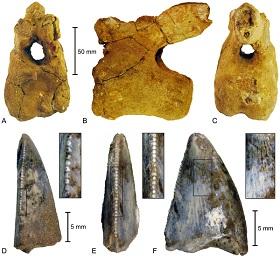Using AI to control energy for indoor agriculture
30 September 2024
Published online 14 January 2014

The first identifiable fossilized dinosaur remains ever found in Saudi Arabia have highlighted the potential of the Arabian Peninsula for future paleontological discovery.
On sites along the Red Sea coast, the researchers excavated seven vertebrae and two teeth, all about 72 million years old. The vertebrae likely belonged to a titanosaur, a diverse group of herbivorous sauropod dinosaurs characterised primarily by their enormous bodies, long necks and small heads. The teeth are probably those of a theropod, a distant relative of Tyrannosaurus rex, which was also carnivorous and walked on its hind legs.
"The vertebrae form a consecutive series and so probably derive from a single animal," says Benjamin Kear, the lead author from Uppsala University, Sweden. "The teeth are harder to place together because they have been shed from the jaw. However, they at least represent the same kind of dinosaur if not the same individual."
Working in collaboration with researchers from Museum Victoria and Monash University in Melbourne, Australia, Kear has been digging for bones in the Adaffa Formation, a thick, layered sequence of quartz arenite sandstone deposits in the northwestern corner of the peninsula. The excavations were carried out under the auspices of the Saudi Geological Survey in Jeddah.
The discovery is significant as very few dinosaur remains have been found in this part of the world and there has not been much exploration for fossils. Millions of years ago, the Arabian Peninsula was attached to northern Africa. Instead of today's arid desert, the region would have had an equatorial climate supporting lush vegetation.
"The main problem is that rocks dating from the time of the dinosaurs were all deposited in marine environments," said Kear. "Dinosaurs lived on land and so their bones and teeth only rarely washed down rivers and out to sea."
Philip Mannion, a palaeontologist at Imperial College London, said the fossils are "a useful addition to our limited knowledge of latest Cretaceous dinosaurs from this region of the world."
Mannion pointed out that "they are the first dinosaur remains from Saudi Arabia [that] can be referred to specific groups, rather than just being considered indeterminate dinosaur bones."
As well as being consistent with the types of dinosaurs known to inhabit the African regions during the Late Cretaceous epoch, the fossils "also extend both the geographical and stratigraphical range of these dinosaurs in the Afro-Arabian region," Kear explained.
"This study is part of an ongoing series of publications that have documented the results of our expeditions in Saudi Arabia," Kear said. "These bones are just the tip of the iceberg, and we are looking forward to more dinosaur discoveries in the future."
doi:10.1038/nmiddleeast.2014.14
Stay connected: